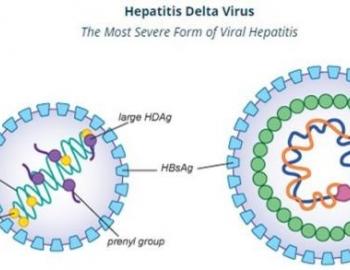Hepatitis D is a liver infection caused by the Hepatitis D virus (HDV), or delta agent, and it can only be contracted by patients who already suffer from hepatitis B (HBV). An individual can, therefore, have hepatitis B and hepatitis D at the same time. Transmission can occur through exposure to contaminated blood, semen, and other bodily fluids. Thus, it can be passed through the transfusion of infected blood or blood product, or by contaminated injections or needles used during a medical procedure.
HDV infection can cause the HBV infection or chronic HBV infection to become more severe, therefore increasing the risk of individuals who have hepatitis B of getting liver disease more rapidly or lead to its worsening.
It is possible to prevent hepatitis D by receiving a vaccination for hepatitis B.
- Hepatitis D virus (HDV) is a virus that requires hepatitis B virus (HBV) for its replication. HDV infection occurs only simultaneously or as super-infection with HBV.
- The virus is most commonly transmitted from mother to child during birth and delivery, as well as through contact with blood or other body fluids.
- Vertical transmission from mother to child is rare.
- Hepatitis D virus (HDV) affects globally nearly 5% of people who have a chronic infection with hepatitis B virus (HBV).
- Several geographical hotspots of high prevalence of HDV infection exist, including Mongolia, the Republic of Moldova, and countries in Western and Middle Africa.
- Populations that are more likely to have HBV and HDV co-infection include people who inject drugs, indigenous populations and recipients of hemodialysis.
- Worldwide, the overall number of HDV infection has decreased since 1980s. This trend is mainly due to a successful global HBV vaccination programme.
- HDV-HBV co-infection is considered the most severe form of chronic viral hepatitis due to more rapid progression towards liver-related death and hepatocellular carcinoma.
- Currently, treatment success rates are generally low.
- Hepatitis D infection can be prevented by hepatitis B immunization.
Hepatitis D is a liver disease in both acute and chronic forms caused by the hepatitis D virus (HDV) that requires HBV for its replication. Hepatitis D infection cannot occur in the absence of hepatitis B virus. HDV-HBV co-infection is considered the most severe form of chronic viral hepatitis due to more rapid progression towards liver-related death and hepatocellular carcinoma.
A vaccine against hepatitis B is the only method to prevent HDV infection.
Symptoms
Symptoms of hepatitis D are similar to those of type B (HBV). These include:
- Jaundice: symptoms of which include yellow eyes and skin, and darker urine
- Fatigue
- Nausea
- Vomiting
- Pain in your abdomen
- Fever
- Muscle or joint pain
Diagnosis
If you display symptoms of either hepatitis D or B, you should consult your doctor about testing and for a proper diagnosis. Your doctor may not always suspect hepatitis unless you give them details that might lead them to believe that you could have been exposed to the virus, especially if you do not develop jaundice. Thus, inform you doctor if you have come in contact with anyone with hepatitis, or think you may have contracted the disease. Tests that are used to diagnose hepatitis include blood tests, liver biopsies and liver function tests. These could help determine whether you have HDV, and whether you have liver damage.
Treatment
Treatment for hepatitis D focuses on treating the symptoms of the disease. For instance, there are some coping techniques available aimed at maintaining comfort as well as an adequate nutritional balance. Consult your doctor for advice on how to manage your symptoms.
If the disease progresses drastically and causes severe damage to your liver, you may become a candidate for a liver transplant.










